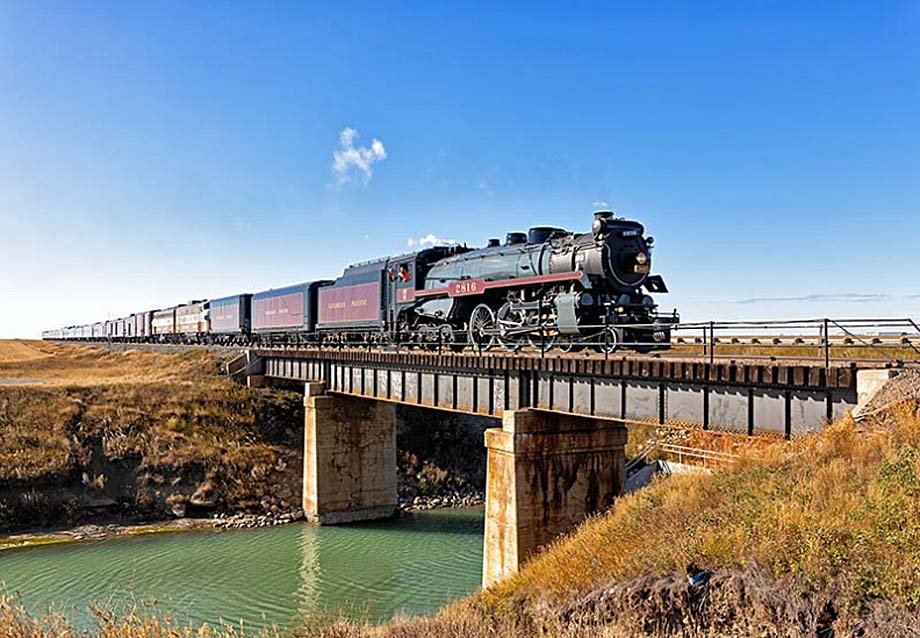
Bucklin Missouri USA
Canada - Canada has a unique connection to the railway.
In 1867, during the Canadian Confederation, the former Crown Colony of British Columbia made its membership contingent
upon the construction of a transcontinental railway.
In a very literal sense, the railways, in this case, Canadian Pacific (CPR), completed in 1884, made the
country.
 No sir... CP was completed on 7 Nov 1885 when the Last Spike was
driven at Craigelachie, British Columbia.
No sir... CP was completed on 7 Nov 1885 when the Last Spike was
driven at Craigelachie, British Columbia.
In 1967, to celebrate the 100th anniversary of the country, the Canadian Broadcasting Corporation commissioned Gordon
Lightfoot to write and perform a song, and his composition, perhaps unsurprisingly, was called the "Canadian
Railroad Trilogy".
Even today, the $10 bill carries on its back an image of a train, via's Canadian, a national symbol.
Put simply, the (CPR, not via) railway is the Canadian origin story.
The country's railways dominated commercial culture for far longer than they did in the U.S., and to a far greater
extent.
Well into the late 20th century, it was possible to cross the Atlantic, stay in a hotel, ride in a sleeping car, board
a ferry, and even fly in a plane, all of which belonged to CPR.
In many ways, the sprawling transportation system once exemplified Canadian culture, international in attitude, global
in reach, and with a railway at its center.
There's also an everyday side to the centrality of the Canadian railway.
Canadian National, assembled from financially struggling companies in the early 20th century, offered a slightly more
downbeat and everyday service, but like CPR stretched from coast to coast, serving countless small towns alongside the
big cities.
Smaller companies, some private, some state-subsidized, pushed iron rails into the remote landscape in search of
natural resources, and in service of settlement and population growth.
Some of the most remarkable examples are not from the 19th century, but from a hundred years later, examples such as
Pacific Great Eastern (later BC Rail), which pushed branches into the far reaches of northern British Columbia
throughout the 1960s and 1970s, chasing minerals, petroleum, and timber traffic.
Wherever you went in Canada, there might not be a road or a highway to get you there, but there was almost always,
almost certainly, a train.
In more recent decades, the centrality of the railway to Canadian life has faded somewhat.
Passenger service was nationalized in 1978 under via, with frequency reductions as duplicative services were
eliminated.
Two daily transcontinental trains became one, then none, when in 1990, via cut service on the Canadian to tri-weekly
in summers and bi-weekly in slower months.
On smaller and shorter routes, many subsidized local services have been reduced.
It is no longer possible to ride RDCs from Victoria 225 miles north to Courtenay on Vancouver Island.
It is no longer possible to buy a train ticket to Cape Breton Island.
Overall, journey times have gotten longer, and ticket prices higher.
As in the U.S., for many Canadians, getting around the country means a plane or a car, not a coach seat in a
streamliner.
Still, Canadians remain almost a generation closer than Americans to a time when daily life centered on the
railways.
As a result, Canada seems far more appreciative of its rail heritage.
From the restoration of CP 2860, the so-called Royal Hudson, during the 1970s to the more recent restorations of CP
2816 earlier this century, and the in-process work on Canadian National 6060, a semi-streamlined 4-8-2, the country has
a long history of succeeding with audacious restoration projects.
Perhaps the nearness of the railway era is more palpable to the north, perhaps the cultural memory of the railways
means that these projects aren't just a trip down memory lane, but a reminder of what it means to be a Canadian at
all.
Regardless of why, our world is the richer for it.
Alexander Benjamin Craghead.
(likely no image with original article)
(usually because it's been seen before)
provisions in Section 29 of the
Canadian Copyright Modernization Act.
